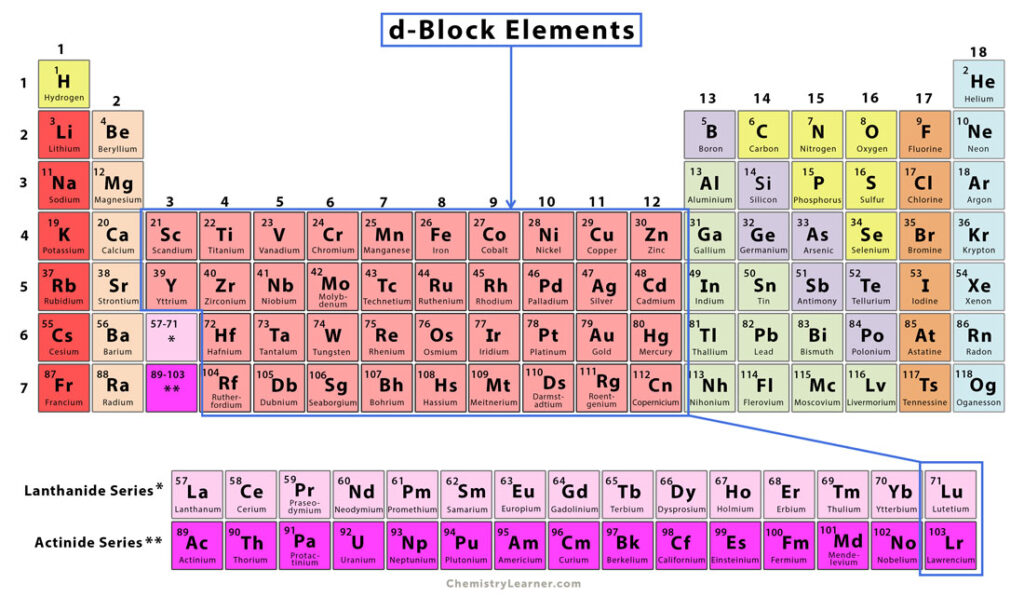
The elements from Group 3 to Group 12 of the periodic table are collectively called the d-block elements. They are called so because the highest energy subshell, i.e., the subshell where the last electron occupies, is a d subshell. There are 40 d-block elements [1-4] .
The d-block elements are also known as transition metals because they transition properties between the s-block elements of Groups 1 and 2 and the p-block elements of Groups 13 to 18.

Generally, electrons are fed into orbitals in order of increasing energy until all the electrons have been accommodated. The general valence shell electron configuration of the d-block elements is (n-1)d 1-10 ns 1-2 . The electrons fill the d subshell of these elements according to the following rules [1-4] .
The valance shell electron configurations of all four series of d-block elements are shown in the following table.
| Period 4 | Sc | Ti | V | Cr | Mn | Fe | Co | Ni | Cu | Zn |
| Electron configuration | 3d 1 4s 2 | 3d 2 4s 2 | 3d 3 4s 2 | 3d 5 4s 1 | 3d 5 4s 2 | 3d 6 4s 2 | 3d 7 4s 2 | 3d 8 4s 2 | 3d 10 4s 1 | 3d 10 4s 2 |
| Period 5 | Y | Zr | Nb | Mo | Tc | Ru | Rh | Pd | Ag | Cd |
| Electron configuration | 4d 1 5s 2 | 4d 2 5s 2 | 4d 4 5s 1 | 4d 5 5s 1 | 4d 5 5s 2 | 4d 7 5s 1 | 4d 8 5s 1 | 4d 10 | 4d 10 5s 1 | 4d 10 5s 2 |
| Period 6 | Lu | Hf | Ta | W | Re | Os | Ir | Pt | Au | Hg |
| Electron configuration | 4f 14 5d 1 6s 2 | 4f 14 5d 2 6s 2 | 4f 14 5d 3 6s 2 | 4f 14 5d 4 6s 2 | 4f 14 5d 5 6s 2 | 4f 14 5d 6 6s 2 | 4f 14 5d 7 6s 2 | 4f 14 5d 9 6s 1 | 4f 14 5d 10 6s 1 | 4f 14 5d 10 6s 2 |
| Period 7 * | Lr | Rf | Db | Sg | Bh | Hs | Mt | Ds | Rg | Cn |
| Electron configuration | 5f 14 7s 2 7p 1 | 5f 14 6d 2 7s 2 | 5f 14 6d 3 7s 2 | 5f 14 6d 4 7s 2 | 5f 14 6d 5 7s 2 | 5f 14 6d 6 7s 2 | 5f 14 6d 7 7s 2 | 5f 14 6d 8 7s 2 | 5f 14 6d 9 7s 2 | 5f 14 6d 10 7s 2 |
Note: * The last four electron configurations are predictions only.
Numerous inconsistencies occur in the electron configuration. They are due to:
The elements having half-filled and completely-filled subshells are generally stable. For example, in Period 4, chromium’s electron configuration is [Ar] 3d 5 4s 1 instead of [Ar] 3d 4 4s 2 . It has half-filled d and s subshells. Another example is copper, whose electron configuration is [Ar] 3d 10 4s 1 instead of [Ar] 3d 9 4s 2 . It has completely-filled d and half-filled s subshells. Similar behavior can be observed in molybdenum, silver in Period 4, and gold in Period 5.
The partially filled d subshell and the ease at which electrons can be removed from or placed in the d orbitals give rise to several unique chemical properties. These include [1-4] :
The 4s electrons are shielded from the atomic nucleus by the 3d electrons. Therefore, the 4s electrons are easier to remove. For example, iron forms Fe 2+ and Fe 3+ as follows:
Fe: [Ar] 3d 6 4s 2
Fe 2+ : [Ar] 3d 6 …… loses 2 4s electrons and gives a green color
Fe 3+ : [Ar] 3d 5 …… loses 2 4s electrons and 1 3d electron and gives a reddish-brown color
And zinc forms colorless Zn 2+ ions only
Zn: [Ar] 3d 10 4s 2
Here, we can introduce the concept of transition metal. A transition metal is a d-block element that forms at least one stable ion with a partially filled d subshell. Iron is a transition metal. However, the elements in Group 12, like zinc, cadmium, and mercury, are not considered transition metals because their stable ions do not have partially filled d subshells. In Period 4, all elements from Ti to Cu are transition metals. We can say that all transition metals are d-block elements. However, not all d-block elements are transition metals.
All transition metals form complex compounds whose central ion has an oxidation number +2 due to the loss of two electrons from the s subshell. However, the d subshell can also lose electrons resulting in stable ions with higher oxidation numbers. Such a phenomenon is possible because the energy levels of ns and (n-1)d subshells are close. Ions can quickly go from one oxidation state to another by accepting or donating electrons.
As in the case of the s-block and p-block elements, the size of neutral atoms of the d-block elements gradually decreases from left to right across a period due to an increase in the effective nuclear charge with increasing atomic number. The atomic radius increases down a group due to increasing atomic number. The increase in size between Period 4 and Period 5 is much more significant than between the Period 5 and Period 6 elements [1-4] .
Due to their unique electron configuration, the d-block elements possess unique physical properties that differ from the s-block and p-block elements. These include [1-4] :
References